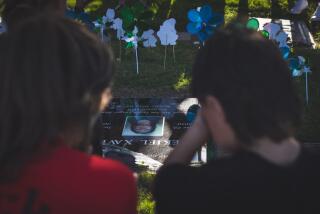Heroin Gets the Best of Suburbs
WASHINGTON — Heroin is the “drug of choice” in Baltimore, and its use is rising in Washington, particularly among the young, said Larry Siegel, the District of Columbia’s senior deputy director for substance abuse services.
When a suburb falls victim, the cause seems as simple as bad luck and proximity to a city with a heroin problem. One, two or a handful of people import heroin into a community, and use spreads like a virus. Recovering addicts trace the outbreak in Maryland’s Carroll County to an addicted teenager who introduced heroin to a circle of Westminster High School seniors in 1994. That circle included Scott Payne, 14, and his friend Kristi Ziemski, who is in prison for killing her mother.
“We’re a very rural area, and you have kids who don’t have a lot to do,” said Linda Auerback, founder of Carroll County’s anti-heroin group, Residents Attacking Drugs, or RAD, whose Web site, https://www.heroinkills.com, and video are now used nationally. “It’s such a trusting community and still kind of quaint in a lot of ways. . . . We had no public awareness of heroin at the time. Heroin was introduced, and you had kids who had money and had cars and were looking for something to do.”
‘Mom. I’m on Heroin. I Need Help.’
“When you first start out,” Kristi Ziemski said, “you think you’re going to have fun and like the feeling, but it takes you over, it’s so powerful. I’ve been in rehab after rehab and detox after detox, and I always went back to it.”
As Ziemski’s addiction deepened, she became pathetically skinny. Black circles as big as 50-cent pieces underscored her eyes.
Her parents, Lee and Doris, knew the cause was drugs but never suspected heroin, Lee said. They didn’t learn the truth until Doris found a note her daughter had written but had thrown in the trash. “Mom,” it said, “I’m on heroin. I need help.” The parents fought. Doris wanted to be lenient; Lee didn’t. Eventually, he moved out and they divorced.
Then Scott Payne died in his sleep on June 5, 1996, just a day after giving his mother a urine sample and saying, “Now do you love me?”
His death hit Kristi hard. Clutching his photograph, she entered her first rehab program. The photo didn’t help: She relapsed within days of leaving. There was another rehab effort, and another. None worked. Such failure is common among heroin addicts, officials say, because most programs are not long enough or intense enough.
Finally, Kristi entered a facility in 1997, emerged clean 30 days later and did not relapse, at least not immediately. “By then,” she said, “I had had a whole lot more bad experiences. I’d gotten raped and gang-raped. I had done prostitution. Just terrible, bad things. I was really tired of the lifestyle.”
She moved in with a sympathetic cousin in Dundalk, Md. She got a job as a waitress. She met a guy and fell in love. They got an apartment. The future looked better.
Beyond her world, Carroll County was finally awakening to heroin’s pull. In January 1998, Liam O’Hara, 15, a Westminster sophomore and soccer player, died in his sleep, having bought heroin at a Burger King where he worked.
After Liam’s death, county prosecutor Jerry F. Barnes, using $4,000 of his own money, launched the “Heroin Kills” publicity campaign, and Auerback and other parents formed RAD.
Lee Ziemski began helping RAD make a video, “Heroin Kills,” a tale of a fictional youngster who dies after snorting heroin. He recalled thinking that the video might help his daughter. He imagined her pitching in to make it. What he didn’t know was that, by then, Kristi had relapsed.
She and her boyfriend had stopped at a friend’s house one day in February 1998. He had 10 clear capsules of heroin on a coffee table. In the kitchen, Kristi saw another. She took it home and snorted the powder. And the spiral began again.
She lost the boyfriend, then the apartment, and began living on the street. To support her $100-a-day habit, she stole money from the restaurant where she worked. Now injecting the heroin, she used veins in her feet, where no one would see marks. In November, she slashed her wrists.
“I didn’t know any other way out,” she said. “I was totally out of it at that point. I totally lost my whole world. I didn’t care about anything anymore.”
She was arrested for prostitution on March 15, 1999, and it was her mother, now 52 and deeply involved in a religious group, who came to get her out of jail. Living in Hampstead, Md., after her divorce, Doris Ziemski was “overboard with religion,” Kristi later told Maryland State Police investigators.
At her townhouse, Doris began reading the Bible to Kristi, interrupted only by trips to church and visits from Doris’ prayer group, who “laid hands” on the girl and prayed in tongues. Kristi’s father recalled that in a telephone conversation, Doris told a relative that she had finally saved Kristi. “She’s a different person,” Doris reportedly said. “You’ll see her. Maybe on Easter.”
On Palm Sunday, March 28, Kristi and Doris began arguing about religion. The mother said the daughter would have to move out if she did not read the Bible and accept religion, according to a police report. Kristi said she was sick of religion. They pushed, shoved. Kristi picked up an Army bayonet--a souvenir from her father’s military days--and brandished it. Doris fled downstairs.
Eventually, Kristi grabbed a butcher knife and stabbed her mother in the chest as Doris “continued to scream that K. Ziemski was the devil,” according to the police report. Doris tried to flee, but Kristi followed, knocked her mother to the floor and stabbed her five more times.
Kristi later told police she was high on heroin. Barnes, who prosecuted the case, said he does not think she was. “There was no indication she didn’t possess the requisite criminal intent,” he said. But Barnes does believe the killing was drug-related, because Kristi was suffering “severe heroin withdrawal” that produced physical sickness and edginess.
Kristi washed off her mother’s blood. She stole her mother’s purse and drove off in her mother’s car to buy heroin. She remembers little about the next 12 days, she said. She stayed in motels in Baltimore, doing heroin she bought with money from her mother’s bank account and returning to her house a couple of times.
The week after the killing, Lee Ziemski had trouble reaching his daughter and ex-wife by phone. He went to the townhouse to check. Through a back door, he could see a body on the floor in the front hall.
Maryland State Police detectives caught up with Kristi the next day, April 9, at a seedy motel in Baltimore. She told them she had no idea why they were there. When she next saw her family, in a courtroom, “hate was all I could see,” she said.
In November, Kristi Ziemski pleaded guilty to murder and was sentenced to life in prison.
More to Read
Sign up for Essential California
The most important California stories and recommendations in your inbox every morning.
You may occasionally receive promotional content from the Los Angeles Times.










